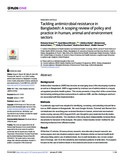Tackling antimicrobial resistance in Bangladesh: A scoping review of policy and practice in human, animal and environment sectors
Date
2020-01-27Publisher
PLOS ONEAuthor
Hoque, RoksanaAhmed, Syed Masud
Naher, Nahitun
Islam, Mohammad Aminul
Rousham, Emily K.
Islam, Bushra Zarin
Hassan, Shaikh
Metadata
Show full item recordCitation
Hoque, R., Ahmed, S. M., Naher, N., Islam, M. A., Rousham, E. K., Islam, B. Z., & Hassan, S. (2020). Tackling antimicrobial resistance in Bangladesh: A scoping review of policy and practice in human, animal and environment sectors. PloS one, 15(1), e0227947. https://doi.org/10.1371/journal.pone.0227947Abstract
Background
Antimicrobial resistance (AMR) has become an emerging issue in the developing countries
as well as in Bangladesh. AMR is aggravated by irrational use of antimicrobials in a largely
unregulated pluralistic health system. This review presents a ‘snap shot’ of the current situa tion including existing policies and practices to address AMR, and the challenges and barri ers associated with their implementation.
Methods
A systematic approach was adopted for identifying, screening, and selecting relevant litera ture on AMR situation in Bangladesh. We used Google Scholar, Pubmed, and Biomed Cen tral databases for searching peer-reviewed literature in human, animal and environment
sectors during January 2010-August 2019, and Google for grey materials from the institu tional and journal websites. Two members of the study team independently reviewed these
documents for inclusion in the analysis. We used a ‘mixed studies review’ method for syn thesizing evidences from different studies.
Result
Of the final 47 articles, 35 were primary research, nine laboratory-based research, two
review papers and one situation analysis report. Nineteen articles on human health dealt
with prescribing and/or use of antimicrobials, five on self-medication, two on non-compli ance of dosage, and 10 on the sensitivity and resistance patterns of antibiotics. Four papers
focused on the use of antimicrobials in food animals and seven on environmental contamination. Findings reveal widespread availability of antimicrobials without prescription
in the country including rise in its irrational use across sectors and consequent contamina tion of environment and spread of resistance. The development and transmission of AMR is
deep-rooted in various supply and demand side factors. Implementation of existing policies
and strategies remains a challenge due to poor awareness, inadequate resources and
absence of national surveillance.
Conclusion
AMR is a multi-dimensional problem involving different sectors, disciplines and stakeholders
requiring a One Health comprehensive approach for containment.

